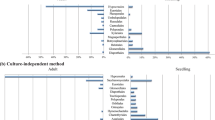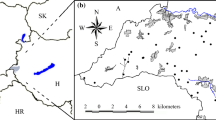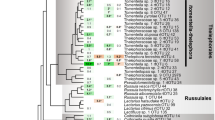Abstract
Endophytic and epiphytic fungal assemblages from stems of S. rotundifolia, a shrubby vine, were studied in order to (1) quantify differences and the degree of overlap between fungal communities of both micro-habitats, and (2) examine whether fungal assemblages are spatially correlated at the local scale (tens to hundreds of meters), in order to understand if dispersal limitation may play a role in structuring these communities. Sampling was conducted over 160 m of growth along a forest edge. The communities showed low overlap (Bray-Curtis Similarity = 0.22), with most species that were common in one habitat appearing rarely if at all in the other, and only Aureobasidium pullulans showing high frequency in both. Epiphytic assemblages proved to be spatially correlated along the 160 m length of the transect, and even more so when adjacent pairs of stems were considered as the unit of comparison rather than individual stems. Endophytic assemblages showed no significant spatial correlation along the transect. Unexpectedly, three species of endophytes showed a pattern in which abundance of colonies peaked at different heights on the stems. Colletotrichum boninense showed peak abundance at 3 cm from the stem base. Phomopsis sp. 1 peaked at 33 cm from the stem base. Endophytic isolates of A. pullulans peaked at 63 cm from the stem tip. It was also found that positive correlative relationships were detected between endophyte-endophyte, and epiphyte-epiphyte pairs. Cross-group interactions seemed to center around crossover species that were not entirely constrained within the surface or interior.







Similar content being viewed by others
Explore related subjects
Discover the latest articles and news from researchers in related subjects, suggested using machine learning.References
Adler PB, HilleRisLambers J, Levine JM (2007) A niche for neutrality. Ecol Lett 10:95–104
Altschul SF, Madden TL, Schaffer AA, Zhang J, Zhang Z, Miller W, Lipman DJ (1997) Gapped BLAST and PSI-BLAST: a new generation of protein database search programs. Nucleic Acids Res 25:3389–3402
Amarasekare P (2003) Competitive coexistence in spatially structured environments: a synthesis. Ecol Lett 6:1109–1122
Ando K (1992) A study of terrestrial aquatic hypohomycetes. Trans Mycol Soc Jpn 33:415–425
Arnold AE, Herre EA (2003) Canopy cover and leaf age affect colonization by tropical fungal endophytes: ecological pattern and process in Theobroma cacao (Malvaceae). Mycologia 95:388–398
Arnold AE, Lutzoni F (2007) Diversity and host range of foliar fungal endophytes: are tropical leaves biodiversity hotspots? Ecology 88:541–549
Bálint M, Tiffin P, Hallström B, O’Hara RB, Olson MS, Frankhauser JD, Piepenbring M, Schmitt I (2013) Host genetype shapes the foliar fungal microbime of balsam poplar (Populus balsamifera). PLoS One 8:e53987
Bernstein ME, Carroll GC (1977) Internal fungi in old-growth Douglas fir foliage. Can J Bot 55:644–653
Bilgrami KS (1963) Studies on conidial dispersal of some pathogenic species of Phyllosticta. Naturwissenschaften 50:360
Boyle C, Götz M, Dammann-Tugend U, Schulz B (2001) Endophyte-host interactions III. Local vs. systemic colonization. Symbiosis 31:259–281
Bray JR, Curtis JT (1957) An ordination of the upland forest communities of southern Wisconsin. Ecol Monogr 27:325–349
Cabral D (1985) Phyllosphere of Eucalyptus viminalis: dynamics of fungal populations. Trans Br Mycol Soc 85:501–511
Carnegie SF (1980) Aerial dispersal of the potato gangrene pathogen, Phoma exigua var. foveata. Ann Appl Biol 94:165–173
Carroll FE, Muller E, Sutton BC (1977) Preliminary studies on the incidence of needle endophytes in some European conifers. Sydowia 29:87–103
Challinor VL, Parsons PG, Chap S, White EF, Blanchfield JT, Lehmann RP, De Voss JJ (2012) Steroidal saponins from the roots of Smilax sp.: structure and bioactivity. Steroids 77:504–511
Chao A (1984) Non-parametric estimation of the number of classes in a population. Scand J Stat 11:265–270
Chao A (1987) Estimating the population size for capture-recapture data with unequal catchability. Biometrics 43:783–791
Chave J, Muller-Landau HC, Levin SA (2002) Comparing classical community models: theoretical consequences for patterns of diversity. Am Nat 159:1–23
Clarke KR (1993) Non-parametric multivariate analysis of changes in community structure. Aust J Ecol 18:117–143
Colwell RK (2013) EstimateS: statistical estimation of species richness and shared species from samples. Version 9. Persistent URL <http://purl.oclc.org/estimates>
Colwell RK, Mao CX, Chang J (2004) Interpolating, extrapolating, and comparing incidence-based species richness. Ecology 85:2717–2727
Colwell RK, Rangel TF (2009) Hutchinson’s duality: the once and future niche. Proc Natl Acad Sci U S A 106:19651–19658
Cordier T, Robin C, Capdevielle X, Desprez-Loustau ML, Vacher C (2012) Spatial variability of phyllosphere fungal assemblages: genetic distance predominates over gographic distance in a European beech stand (Fagus sylvatica). Fungal Ecol 5:509–520
Damm U, Verkley GJM, Crous PW, Fourie PH, Haegi A, Riccioni L (2008) Novel Paraconiothyrium species on stone fruit trees and other woody hosts. Persoonia 20:9–17
Davey ML, Heegaard E, Halvorsen R, Ohlson M, Kauserud H (2012) Seasonal trends in biomass and structure of bryophyte-associated fungal communities explored by 454 pyrosequencing. New Phytol 195:844–856
Devarajan PT, Suryanarayanan TS (2006) Evidence for the role of phytophagous insects in dispersal of non-grass fungal endophytes. Fungal Divers 23:111–119
Dickinson CH (1965) The mycoflora associated with Halimione portulacoides: III. Fungi on green and moribund leaves. Trans Br Mycol Soc 48:603–610
Elamo P, Helander ML, Saloniemi I, Neuvonen S (1999) Birch family and environmental conditions affect endophytic fungi in leaves. Oecologia 118:151–156
Elton C (1927) Animal ecology. The Macmillan Company, New York
Espinosa-Garcia FJ, Rollinger JL, Langenheim JH (1996) Coastal redwood endophytes: their occurrence, interactions and response to host volatile terpenoids. In: Redlin SC, Carris LM (eds) Endophytic fungi in grasses and woody plants. APS Press, St Paul, pp 87–100
Fisher R, Nadav N, Chaimovitsh D, Rubin B, Dudai N (2011) Variation in essential oil composition within individual leaves of sweet basil (Ocimum basilicum L.) is more affected by leaf position than by leaf age. J Agric Food Chem 59:4913–4922
Fisher PJ, Anson AE, Petrini O (1986) Fungal endophytes in Ulex europaeus and Ulex gallii. Trans Br Mycol Soc 86:153–193
Fröhlich J, Hyde KD (1999) Biodiversity of palm fungi in the tropics: are global fungal diversity estimates realistic? Biodivers Conserv 8:977–1004
Flessa F, Peršoh D, Rambold G (2012) Annuality of central European deciduous tree leaves delimits community development of epifoliar pigmented fungi. Fungal Ecol 5:554–561
Gao XX, Zhou H, Xu DY, Yu CH, Chen YQ, Qu LH (2005) High diversity of endophytic fungi from the pharmaceutical plant, Heterosmilax japonica Kunth revealed by cultivation-independent approach. FEMS Microbiol Lett 249:255–266
Gazis R, Chaverri P (2010) Diversity of fungal endophytes in leaves and stems of wild rubber trees (Hevea brasiliensis) in Peru. Fungal Ecol 3:240–254
Geange S, Pledger S, Burns KC, Shima JS (2011) A unified analysis of niche overlap incorporating data of different types. Methods Ecol Evol 2:175–184
Gause GF (1934) The struggle for existence. Williams and Wilkins, Baltimore
Gönczöl J, Révay Á (2004) Fungal spores in rainwater: stemflow, throughfall and gutter conidial assemblages. Fungal Divers 16:67–86
Gönczöl J, Révay Á (2006) Species diversity of rainborne hyphomycete conidia from living trees. Fungal Divers 22:37–54
Hammer O, Harper DAT, Ryan PD (2001) PAST: paleontological statistics software package for education and data analysis. Palaeontol Electron 4(1):9pp
Hudson HJ (1968) The ecology of fungi on plant remains above the soil. New Phytol 67:837–874
Hudson HJ, Webster J (1958) Succession of fungi on decaying stems of Agropyron repens. Trans Br Mycol Soc 41:165–177
Hutchinson GE (1957) Concluding remarks. Cold Spring Harbor Symp Quant Biol 22:415–427
Hutchinson GE (1978) An introduction to population ecology. Yale University Press, New Haven
Jost L (2006) Entropy and diversity. Oikos 113:363–375
Jumpponen A, Jones KL (2010) Seasonally dynamic fungal communities in the Quercus macrocarpa phyllosphere differ between urban and nonurban environments. New Phytol 186:496–513
Kendrick B, Burges A (1962) Biological aspects of the decay of Pinus sylvestris leaf litter. Nova Hedwig 4:313–342
Kerr B, Riley MA, Feldman MW, Bohannan BJM (2002) Local dispersal promotes biodiversity in a real-life game of rock-paper-scissors. Nature 418:171–174
Kharwar RN, Gond SK, Anuj K, Mishra A (2010) A comparative study of endophytic and epiphytic fungal association with leaf of Eucalyptus citriodora Hook., and their antimicrobial activity. World J Microbiol Biotechnol 26:1941–1948
Koljalg U, Nilsson RH, Abarenkov K et al (2013) Towards a unified paradigm for sequence-based identification of fungi. Mol Ecol 22:5271–5277
Legault D, Dessureault M, Laflamme G (1989a) Mycoflore des aiguilles de Pinus banksiana et Pinus resinosa I. champignons endophytes. Can J Bot 67:2052–2060
Legault D, Dessureault M, Laflamme G (1989b) Mycoflora of Pinus banksiana and Pinus resinosa needles. II. Epiphytic fungi. Can J Bot 67:2061–2065
Luttrell ES (1944) The morphology of Myiocopron smilacis (De Not.) Sacc. Am J Bot 31:640–649
Magurran AE (2004) Measuring biological diversity. Blackwell Science Ltd, Malden
Mantel N (1967) The detection of disease clustering and a generalized regression approach. Cancer Res 27:209–220
Macauley BJ, Thrower LB (1966) Succession of fungi in leaf litter of Eucalyptus regnans. Trans Br Mycol Soc 49:509–520
Mariano RLR, Lira RVF, Silveira EB, Menezes M (1997) Levantamento de fungos endofíticos e epifíticos em folhas de coqueiro no Nordeste do Brasil. I. Frequüência da população fúngica e efeito da hospedeira. Agrotrópica 9:127–134
Marquez SS, Bills GF, Zabalgogeazcoa I (2007) The endophytic mycobiota of the grass Dactylis glomerata. Fungal Divers 27:171–195
Mishra A, Gond SK, Kumar A, Sharma VK, Verma SK, Kharwar RN, Sieber TN (2012) Season and tissue type affect fungal endophyte communities of the Indian medicinal plant Tinospora cordifolia more strongly than geographic location. Microb Ecol 64:388–398
Moncalvo JM, Wang HH, Hseu RS (1995) Phylogenetic relationships in Ganoderma inferred from the internal transcribed spacer and 25S ribosomal DNA sequences. Mycologia 87:223–238
Moy M, Belanger F, Duncan R, Freehoff A, Leary C, Meyer W, Sullivan R, White JF (2000) Identification of epiphyllous mycelial nets on leaves of grasses infected by Clavicipitaceous endophytes. Symbiosis 28:291–302
Mucciarelli M, Camusso W, Maffei M, Panicco P, Bicchi C (2007) Volatile terpenoids of endophyte-free and infected peppermint (Mentha piperita L.): chemical partitioning of a symbiosis. Microb Ecol 54:685–696
Munafo JP, Gianfagna TJ (2011) Quantitative analysis of steroidal glycosides in different organs of Easter lily (Lilium longiflorum Thunb.) by LC-MS/MS. J Agric Food Chem 59:995–1004
Nix-Stohr S, Moshe R, Dighton J (2008) Effects of propagule density and survival strategies on establishment and growth: further investigations in the phylloplane fungal model system. Microb Ecol 55:38–44
Osono T (2002) Phyllosphere fungi on leaf litter of Fagus crenata: occurrence, colonization, and succession. Can J Bot 80:460–469
Osono T (2008) Endophytic and epiphytic phyllosphere fungi of Camellia japonica: seasonal and leaf age-dependent variations. Mycologia 100:387–391
Osono T, Bhatta BK, Takeda H (2004) Phyllosphere fungi on living and decomposing leaves of giant dogwood. Mycoscience 45:35–41
Osono T, Mori A (2004) Distribution of fungi within the canopy of giant dogwood. Mycoscience 45:161–168
Osono T, Takeda H (1999) Decomposing ability of interior and surface fungal colonizers of beech leaves with reference to lignin decomposition. Eur J Soil Biol 35:51–56
Parker PE, Ramsdell DC (1977) Epidemiology and chemical control of Phomopsis canker of highbush blueberry. Phytopathology 67:1481–1484
Peršoh D (2013) Factors shaping community structure of endophytic fungi–evidence from the Pinus-Viscum-system. Fungal Divers 60:55–69
Petrini O (1991) Fungal endophytes of tree leaves. In: Andrews JH, Hirano SS (eds) Microbial ecology of leaves. Springer, New York, pp 179–197
Petrini O (1996) Ecological and physiological aspects of host-specificity in endophytic fungi. In: Redlin SC, Carris LM (eds) Endophytic fungi in grasses and woody plants. APS Press, St Paul, pp 87–100
Prior R, Gorges K, Yurkov A, Begerow D (2014) New isolation method for endophytes based on enzyme digestion. Mycol Prog 1–8, doi:10.1007/s11557-014-0968-0
Pugh GJF, Buckley NG (1971) The leaf surface as a substrate for colonization by fungi. In: Preece TF, Dickinson CH (eds) Ecology of leaf surface micro-organisms. Academic, London, pp 431–445
Qi Z, Cameron KM, Li P, Zhao Y, Chen S, Chen G, Fu C (2013) Phylogenetics, character evolution, and distribution patterns of the greenbriers, Smilacaceae (Liliales), a near-cosmopolitan family of monocots. Bot J Linn Soc 173:535–548
Révay Á, Gönczöl J (2011) Canopy fungi (“terrestrial aquatic hyphomycetes”) from twigs of living evergreen and deciduous trees in Hungary. Nova Hedwig 92:303–316
Reynolds DR (1999) Capnodium citri: the sooty mold comprising the taxon concept. Mycopathology 148:141–147
Rodrigues KF (1994) The foliar fungal endophytes of the Amazonian plam Euterpe oleracea. Mycologia 86:376–385
Ruscoe QW (1971) Mycoflora of living and dead leaves of Nothofagus truncata. Trans Br Mycol Soc 56:463–474
Santamaria J, Bayman P (2005) Fungal epiphytes and endophytes of coffee leaves (Coffea arabica). Microb Ecol 50:1–8
Saunders M, Kohn LM (2008) Host-synthesized compounds influence the in vitro interactions between fungal endophytes of maize. Appl Environ Microbiol 74:136–142
Serrato-Díaz LM, Rivera-Vargas LI, Goenaga R (2010) First report of sooty mold of longan (Dimocarpus longan L.) caused by Tripospermum porosporiferum Matsushima and T. variabile Matsushima in Puerto Rico. J Agric Univ P R 94:285–287
Sørensen T (1948) A method of establishing groups of equal amplitude in plant sociology based on similarity of species and its application to analyses of the vegetation on Danish commons. K Dan Vidensk Selsk 5:1–34
Stone JK (1987) Initiation and development of latent infetions by Rhabdocline parkeri on Douglas-fir. Can J Bot 65:2614–2621
Stone JK, Polishook JD, White JF (2004) Endophytic fungi. In: Mueller GM, Bills GF, Foster MS (eds) Biodiversity of fungi, inventory and monitoring methods. Elsevier Academic Press, Burlington, pp 241–270
Sun X, Ding Q, Hyde KD, Guo LD (2012) Community structure and perference of endophytic fungi of three woody plants in a mixed forest. Fungal Ecol 5:624–632
Tadych M, Bergen MS, Johnson-Cicalese J, Polashock JJ, Vorsa N, White JF (2012) Endophytic and pathogenic fungi of developing cranberry ovaries from flower to mature fruit: diversity and succession. Fungal Divers 54:101–116
Taguchi YH, Oono Y (2005) Relational patterns of gene expression via non-metric multidimensional scaling analysis. Bioinformatics 21:730–740
Unterseher M, Schnittler M (2009) Dilution-to-extinction cultivation of leaf-inhabiting endophytic fungi in beech (Fagus sylvatica L.) - Different cultivation techniques influence fungal biodiversity assessment. Mycol Res 113:645–654
Van Bael SA, Maynard Z, Rojas E, Mejia LC, Kyllo DA, Here EA (2005) Emerging perspectives on the ecological roles of endophytic fungi in tropical plants. In: Dighton J, White JF, Oudemans P (eds) The fungal community: its organization and role in the ecosystem. Taylor and Francis group, Boca Raton, pp 181–192
Vilgalys R, Hester M (1990) Rapid genetic identification and mapping of enzymatically amplified ribosomal DNA from several Cryptococcus species. J Bacteriol 172:4238–4246
Watson ES, McClurkin DC, Huneycutt MB (1974) Fungal succession on loblolly pine and upland hardwood foliage and litter in North Mississippi. Ecology 55:1128–1134
Wang Y, Guo LD (2007) A comparative study of endophytic fungi in needles, bark, and xylem of Pinus tabulaeformis. Can J Bot 85:911–917
Wearn JA, Sutton BC, Morley NJ, Gange AC (2012) Species and organ specificity of fungal endophytes in herbaceous grassland plants. J Ecol 100:1085–1092
Webster J (1956) Succession of fungi on decaying cocksfoot culms, Part I. J Ecol 44:517–535
Webster J (1957) Successoin of fungi on decaying cocksfoot culms, Part II. J Ecol 45:1–30
Wei JG, Xu T, Guo LD, Liu AR, Zhang Y, Pan XH (2007) Endophytic Pestalotiopsis species associated with plants of Podocarpaceae, Theaceae, and Taxaceae in southern China. Fungal Divers 24:55–74
Whittaker RH (1965) Dominance and diversity in land plant communities. Science 147:250–260
White TJ, Bruns T, Lee S, Taylor JW (1990) Amplification and direct sequencing of fungal ribosomal RNA genes for phylogenetics. In: Innis MA, Gelfand DH, Sninsky JJ, White TJ (eds) PCR protocols: a guide to methods and applications. Academic Press, Inc., New York, pp 315–322
Wildman HG, Parkinson D (1979) Microfungal succession on living leaves of Populus tremuloides. Can J Bot 57:2800–2811
Wrona B, Grabowski M (2004) Etiology of apple sooty blotch in Poland. J Plant Prot Res 44:293–297
Yadav AS (1966) The ecology of microfungi on decaying stems of Heracleum sphondylium. Trans Br Mycol Soc 49:471–485
Yang X, Wilson LL, Madden LV, Ellis MA (1990) Rain splash dispersal of Colletotrichum acutatum from infected strawberry fruit. Phytopathology 80:590–595
Zimmerman NB, Vitousek PM (2012) Fungal endophyte communities reflect environmental structuring across a Hawaiian landscape. Proc Natl Acad Sci U S A 109:13022–13027
Acknowledgments
We are grateful to the H. Boyd and Jeanette Woodruff Graduate Fellowship in Soils and Environmental Microbiology, the Rutgers Turf Research Fund, The John and Christina Craighead Foundation, U.S.D.A. Multistate Project W3147, and the New Jersey Mycological Association for financial support. We thank Dr. Peter Morin for advice on aspects of study design.
Author information
Authors and Affiliations
Corresponding author
Rights and permissions
About this article
Cite this article
Zambell, C.B., White, J.F. In the forest vine Smilax rotundifolia, fungal epiphytes show site-wide spatial correlation, while endophytes show evidence of niche partitioning. Fungal Diversity 75, 279–297 (2015). https://doi.org/10.1007/s13225-014-0316-3
Received:
Accepted:
Published:
Issue Date:
DOI: https://doi.org/10.1007/s13225-014-0316-3




